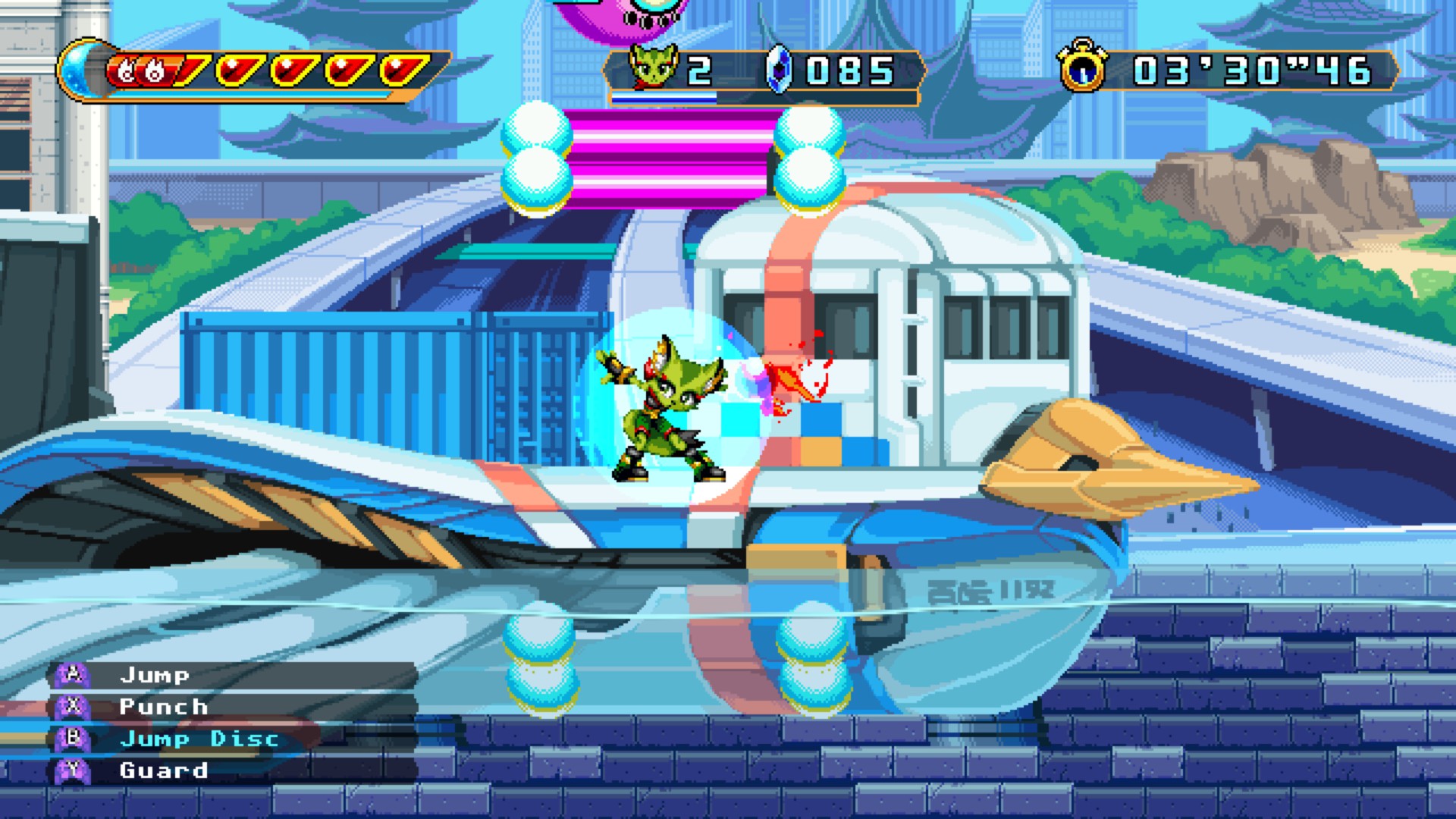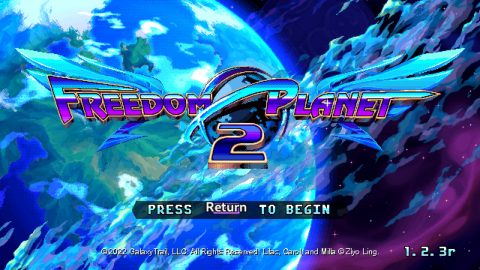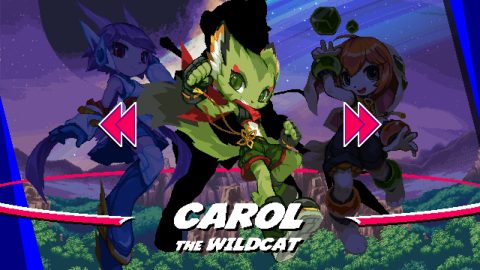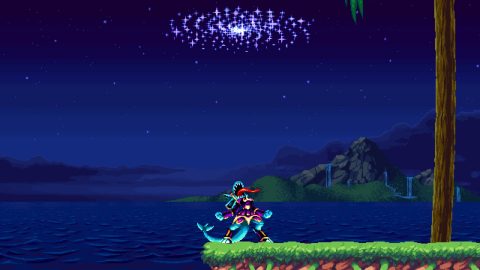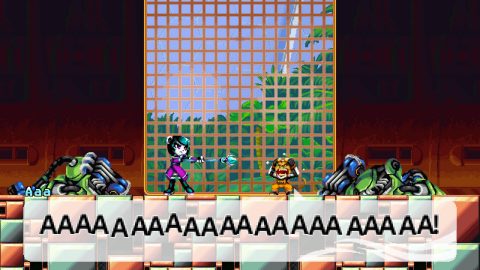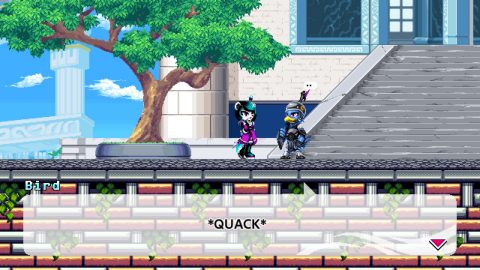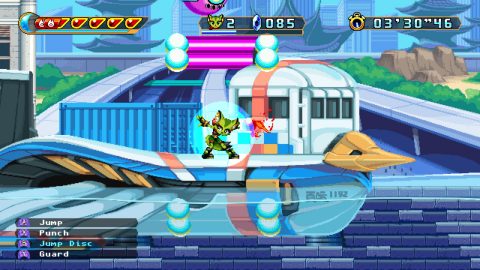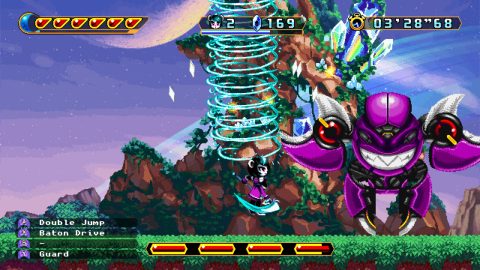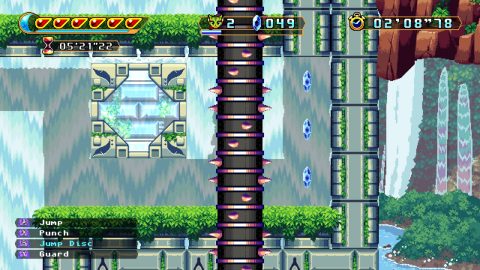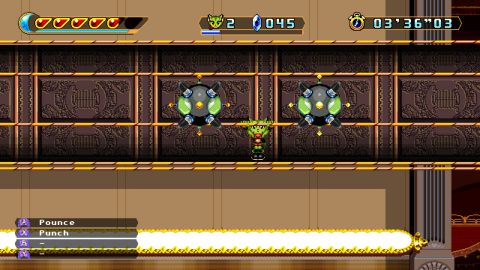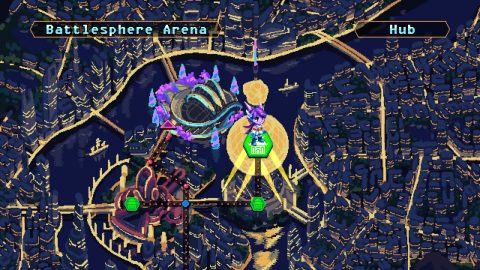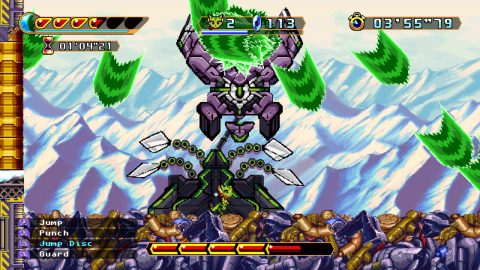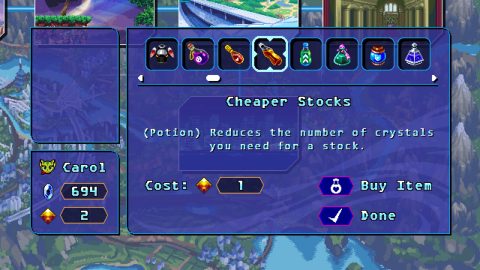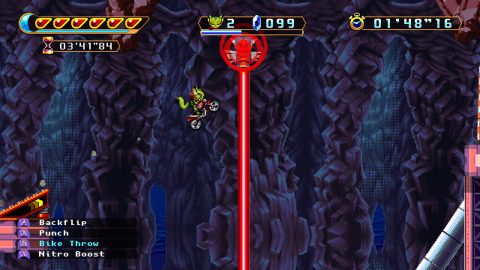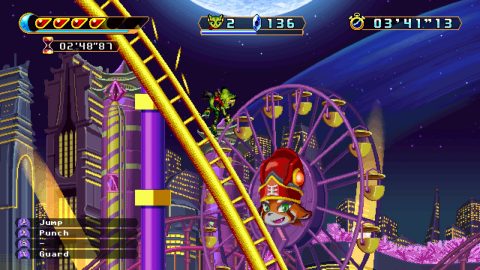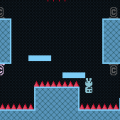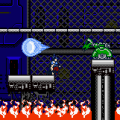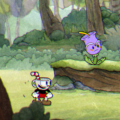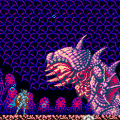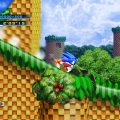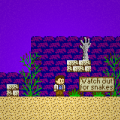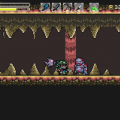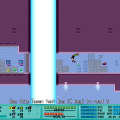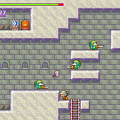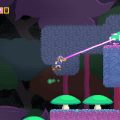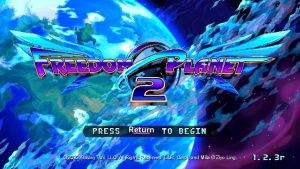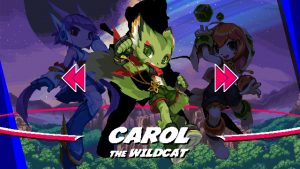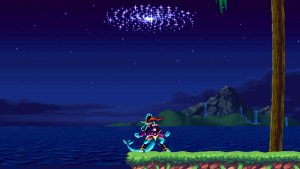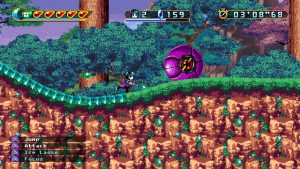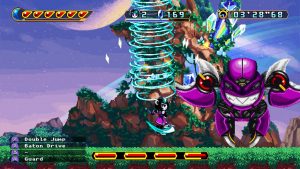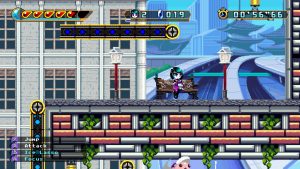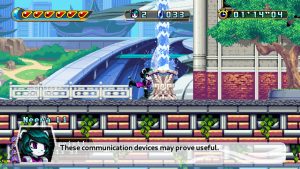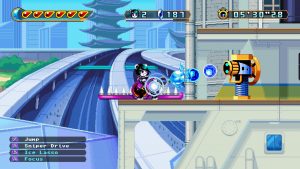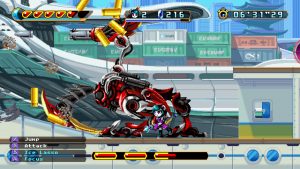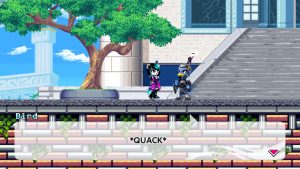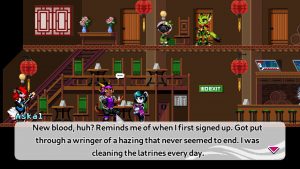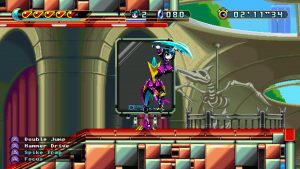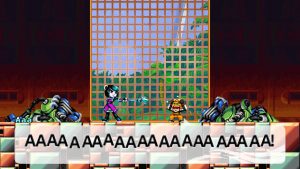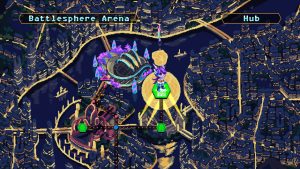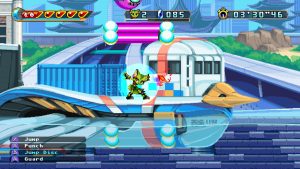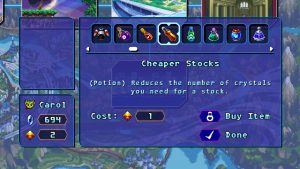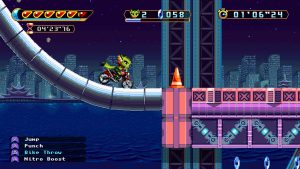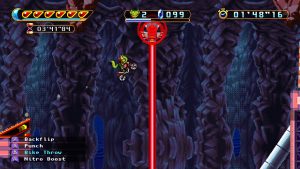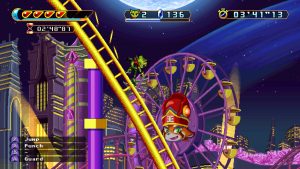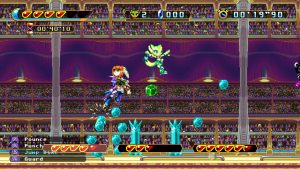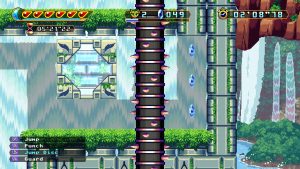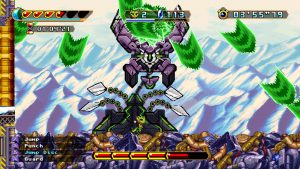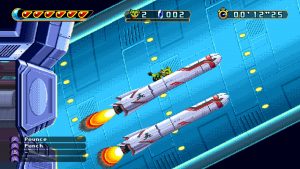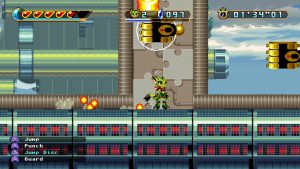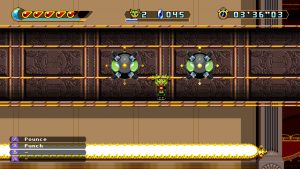- Freedom Planet
- Freedom Planet 2
When it comes to the retro indie scene, more often than not, the inspiration generally comes from Nintendo and the many great series that spawned off from their systems. That’s what made the original Freedom Planet so welcome to see. A tribute to all the fantastic action platformers of the Genesis, the game drew more from classics like Pulseman, rather than Mega Man. (And yes, perhaps more than a little bit of Sonic the Hedgehog.) Truth be told, the game doesn’t do anything wildly different from what the original game did – but the foundation was more than strong enough that with its issues rectified, it makes for an even better game regardless.
The four heroines, with Neera-Li just offscreen
Three years have passed since the evil Lord Brevon’s forced retreat from the planet Avalice. The long peace is broken, however, when a rampaging robot destroys Lilac and Carol’s treehouse home. They’re soon summoned by the local magister to investigate a new robotic invasion plaguing the planet. It turns out that a water dragon warrior named Merga is behind it, seeking revenge for ancient atrocities against her kind. Given the kind of game it is, it’s not much of a surprise a planet-destroying superweapon eventually gets involved.
The story was one of the largest complaints against the original game, both for the length of the cutscenes and an infamous shift in tone. While the cutscenes are generally shorter, there are generally more of them – mostly because they tend to play after each stage, of which there are many more. The tone is much more even. There are brief mentions of trauma, colonialism, and even genocide within the story, and yet nothing is touched upon too deeply to get uncomfortable or shift the cartoony style out of balance. Merga makes for a threatening villain, but not quite as murderous as Brevon, and her squad of goofy bosses helps to take some of the potential edge off of her.
Pictured: A goofy boss
There’s still the same earnestness to the story as the first game had. The voice acting, while recorded with better equipment and now featuring famous talent like DBZ’s Christopher Sabat, still has that charming, mid-90s dub feel. If you didn’t particularly care for the story and characters of the first game, however, it’s unlikely you’ll be turned around this time. The Classic mode that skips the cutscenes is now unlocked by beating the game once, which some people might find issue with, but the option to skip the cutscenes is still there, if necessary.
NPCs in hub areas usually have a little more to say than this.
The basics from the first game remain – it’s still a high-speed platformer with an emphasis on melee combat. One new addition for the whole cast is a ‘guard’ button, which makes the character go into a Smash Brothers-esque invincible dodge when used. Given how much more complicated boss encounters especially can be, it’s a handy technique you’ll want to use whenever possible. The returning cast have some new moves – Lilac can extend her dodge into a short dash to keep the i-frames going, Carol can throw out a spinning disk to extend her reach in any direction, and Milla gets both short range melee attacks and rapid-fire blasting capabilities to take out weaker enemies with.
Dodging early and dodging often is the key to mastering the constant enemy attack you’ll be up against.
Joining the playable cast is Neera-Li, loyal panda soldier of the magister and former mid-boss. Her focus is more on combat, with a variety of ice-based techniques that deliver more damage at once than the other heroes. However, her traversal abilities aren’t quite as strong as Carol or Lilac, with only a double jump to help her get more vertical height.
The game matches the original game’s mixture of speed, platforming and combat quite well, albeit with what feels like a somewhat greater emphasis on speed. Particular level features that send you hurtling through the air or speeding across the ground feel a lot more common, with a few stretches where you’ll find yourself hurdled along where you need to go. That’s not to say that’s all there is to expect, as the game does just as fine of a job mixing things up.
The level design is very strong throughout, with the most noticeable improvement being the length of the levels themselves. A common complaint was that the levels were long enough to induce fatigue before they were finished. This time around, levels are generally half as long, even with a boss fight at the end of each one. Shorter, however, doesn’t mean they’re any less interesting or complicated, with plenty of twists to be found.
Tiger Falls introduces these ‘windows’ you can move between layers with to avoid these nasty pillars.
One level has you exploring a massive opera house, revisiting previous stages as literal stage sets. Another forces you to hold out against a horde of foes long enough to find three pieces of a mech scattered across the stage. It’s one of the game’s tougher segments, but successfully putting the machine back together lets you take control of it and get some much-wanted payback. Even the ‘regular’ stages are just as strong, however, with each one offering unique elements to make use of.
The boss fights are just as much of a focus as the original game, featuring massive, segmented Treasure-esque robots, with a few battles between rivals of your own size for variety. These more often than not will be where you’ll be spending most of your lives, as fast attacks and complicated patterns often demand frequent and well-timed used of the guard button.
A few refinements have been made to the overall game structure as well. Between levels, a world map appears, which leads to new areas of the planet as you make progress, as well as letting you revisit stages you’ve already cleared. A handful of locations on the map are hub areas, where you can converse with various NPCs and buy stuff with the crystals and robot parts you’ve collected. They make for nice breaks in what would be otherwise constant action otherwise, and provide a little extra backstory for those seeking it out. Occasionally, the game also gives you a choice of ‘episodes’, each of which is split into several levels. This more determines the order of stages you’ll play than anything, as you’ll need to finish each episode to progress further.
In the original game, while your lives were limited, continues brought you back to your last checkpoint, making the system more of an aesthetic choice than anything. This time around, each level grants you three lives, and while you can earn more, they won’t carry between stages – not unlike Mega Man 8. Running out of lives means either spending a portion of your hard-earned crystals to hit your last checkpoint, or restarting from the beginning of a stage. In addition, upon losing a life, you can either choose to go back to your last checkpoint, or instantly revive yourself with only a hit or two to spare. Generally, this option is best for when you’ve nearly defeated a difficult boss and just need to get that last hit in, but it’s useful regardless.
The shops you’ll find at the various hub areas carry items that you can bring into a stage, each of which affect the game in various ways. Amulets and Charms can be equipped into one of two slots, offering useful effects like longer invincibility periods or letting you automatically dodge incoming attacks, at the expense of a lower crystal payout on stage completion. Brave Stones, equipped in the same two slots, instead make things more difficult in exchange for more bonus crystals at the end of the stage, like doubling incoming damage or disabling your guard button. There are also potions, which can be stacked in different ways to a total of five slots, letting you decide which buffs you want and how effective you want them to be.
If a tough boss is giving you trouble, experiment with your items and potions to help yourself out.
It makes for what feels like a truly massive game – at least six hours or so if you’re taking the time to watch the cutscenes or explore the hub areas. It’s about half that if you skip all that, which is still more than plenty for the genre. Completionists have plenty to do as well, with each regular stage hiding a hidden music track and treasure chest. One particular stage offers a variety of challenges and boss rematches to check out, with the game’s true ending hiding behind finishing each of them. This, admittedly, isn’t very well communicated by the game itself, but finishing these tasks is a fairly reasonable challenge.
The graphics have received a massive overhaul, as well – while the first game made use of a style that brought to mind somewhere between a 32X and a Saturn in fidelity, the sequel drops those artificial constraints in favor of something more modern. The resolution makes use of a far higher resolution, allowing more to be on screen – with the game zooming the camera out at appropriate moments, which is always helpful. The pixel art is beautiful, with the backgrounds in particular having some real artistic care put into them. The game also makes the occasional use of low-poly 3D, which while it doesn’t appear very often, definitely stands out when it does.
Somewhat more subjectively, the more “Sonic-esque” trappings have been dropped in favor of a more unique style. Characters have taller, somewhat more humanoid proportions, elemental shields have been replaced with colored wisps, and an ominous ticking clock no longer warns you when you’re about to run out of air. It really helps the game stand out as its own, even if the inspiration can still be felt in the base gameplay itself.
In a sphere where it often still feels like Nintendo reigns supreme, the game is overall probably one of the best of its kind in a rare few. It doesn’t change as much as it refines, and considering how strong the original game was, that’s absolutely fine. Whatever flaws the original game have had are mostly gone, leaving a polished work with seemingly nowhere else to go from here, at least gameplay wise. Except, perhaps, a first step into the third dimension.
